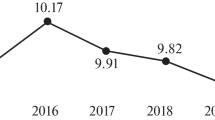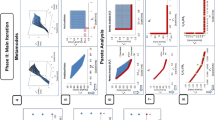Abstract
A general framework to describe operating policies in manufacturing cells is presented. A policy can be characterized by assigning appropriate values to a set of descriptive parameters. System configuration is described by one set of parameters and operating policies by another. Examples are presented to illustrate the choice of parameter values. The framework forms the basis for a general-purpose discrete-event simulator. This simulator is used to study various operating philosophies under a wide variety of operating environments.
Similar content being viewed by others
References
R.G. Askin and A. Iyer, A comparison of scheduling philosophies for manufacturing cells, European Journal of Operationsal Research 69(1993)438 - 449.
R.G. Askin and A. Iyer, Strategies for controlling the flow of material through manufacturing cells, Technical Report, Department of Systems and Industrial Engineering, University of Arizona, Tucson, AZ, 1994.
R.G. Askin, J.B. Goldberg, S.H. Creswell and A.J. Vakharia, A Hamiltonian path approach for restructuring the part - machine matrix for cellular manufacturing, International Journal of Production Research 29(1991)1081 - 1100.
R.G. Askin and P.S. Subramanyam, A cost based heuristic for Group Technology configuration, International Journal of Production Research 25(1987)101 - 113.
J.J. Bartholdi III and D.D. Eisenstein, A production line that balances itself, Technical Report, Georgia Institute of Technology, School of Industrial and Systems Engineering, 1993.
S. Benjaafar, Machine sharing in cellular manufacturing systems, in: Planning, Design and Analysis of Cellular Manufacturing Systems, A.K. Kamrani, H.R. Parsaei and D.H. Liles, eds., Elsevier Science, 1995, pp. 203 - 228.
D.P. Bischak, Throughput of a manufacturing module with moving workers, Technical Report, Department of Business Administration, University of Alaska, Fairbanks, 1993.
J.A. Buzacott and J.G. Shanthikumar, A general approach for coordinating production in multiple-cell manufacturing systems, Journal of Production and Operations Management 1(1992)34 - 52.
I. Ham, K. Hitomi and T. Yoshida, Group Technology Applications to Production Management, Kluwer-Nijhoff, Boston, MA, 1985.
G.L. Hogg, D.T. Phillips, M.J. Maggard and W.G. Lesso, GERTS QR: A model for multi-resource constrained queueing systems: Part I, AIIE Transactions 7(1975)89 - 99.
G.L. Hogg, D.T. Phillips, M.J. Maggard and W.G. Lesso, GERTS QR: A model for multi-resource constrained queueing systems: Part II: An analysis of parallel-channel dual-resource constrained queueing systems with homogeneous resources, AIIE Transactions 7(1975)100 - 109.
P.Y. Huang, L.J. Moore and R.S. Russell, Workload versus scheduling policies in a dual resource constrained job shop, Computers and Operations Research 11(1984)37 - 48.
A. Iyer and R.G. Askin, A model for the dedicated cell loading policy for manufacturing cells, Technical Report, Department of Systems and Industrial Engineering, The University of Arizona, Tucson, AZ, 1995.
J.R. King, Machine component grouping in production flow analysis: An approach using a rank ordering clustering algorithm, International Journal of Production Research 18(1980)213 - 232.
F. Mahmoodi and K.J. Dooley, A comparison of exhaustive and non-exhaustive group scheduling heuristics in a manufacturing cell, International Journal of Production Research 29(1991)1923-1939.
M.K. Malhotra and H.V. Kher, A comparison of worker assignment policies for dual resource constrained shops, International Journal of Production Research 32(1994)1087 - 1103.
J.S. Morris and R.J. Tersine, A comparison of cell loading practices in Group Technology, Journal of Operations Management 2(1989)299 - 313.
C.T. Mosiers, D.A. Elviers and D. Kelly, Analysis of Group Technology scheduling heuristics, International Journal of Production Research 22(1984)857 - 875.
R.T. Nelson, Labor and machine limited production systems, Management Science 13(1967)648 -671.
R.T. Nelson, A simulation of labor efficiency and centralized assignment in a production model, Management Science 17(1970)B97 - B106.
R.S. Russell, P.Y. Huang and Y. Leu, A study of labor allocation strategies in cellular manufacturing, Decision Sciences 22(1991)594 - 610.
M.L. Spearman, D.L. Woodruff and W.J. Hopp, CONWIP: A pull alternative to kanban, International Journal of Production Research 28(1990)879 - 894.
M.M. Srinivasan, An approximation for mean waiting times in cyclic server systems with non-exhaustive service, Performance Evaluation 9(1988)17 - 33.
R.M. Sundaram, Some scheduling rules for a Group Technology manufacturing system, in: Computer Applications in Production and Engineering, Ackerman, ed., 1983, pp. 765 - 772.
H. Takagi, Queueing analysis of polling models: An update, in: Stochastic Analysis of Computer and Communication Systems, H. Takagi, ed., Elsevier Science/North-Holland, 1990, pp. 267 - 318.
R. Vaithianathan and K.L. McRoberts, On scheduling in a GT environment, Journal of Manufacturing Systems 1(1982)149 - 155.
A. Vakharia and U. Wemmerlöv, Designing a cellular manufacturing system: A materials flow approach based on operation sequences, IIE Transactions 22(1990)84 - 96.
J.K. Weeks and J.S. Fryer, A simulation study of operating policies in a hypothetical dual-constrained job shop, Management Science 22(1976)1362 - 1371.
Rights and permissions
About this article
Cite this article
Iyer, A., Askin, R.G. A general framework for comparing operating policies in manufacturing cells. Annals of Operations Research 77, 23–50 (1998). https://doi.org/10.1023/A:1018929512306
Issue Date:
DOI: https://doi.org/10.1023/A:1018929512306




